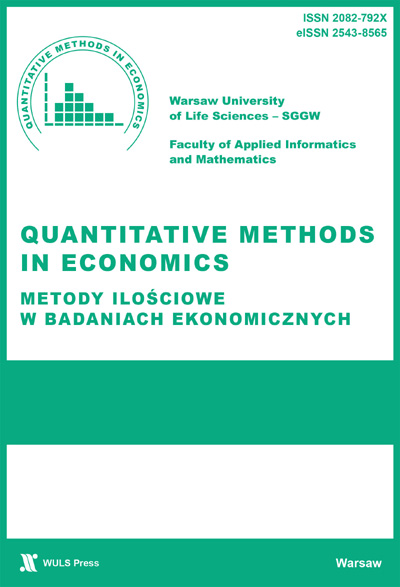Main Article Content
Article Details
Agarwal M. K., Green P. E. (1991) Adaptive Conjoint Analysis versus Selfexplicated Models: Some Empirical Results. International Journal of Research in Marketing, 8(2), 141-146. (Crossref)
Chen Ch. F., Rothschild R. (2010) An Application of Hedonic Pricing Analysis to the Case of Hotel Rooms in Taipei. Tourism Economics, 16(3), 685-94. (Crossref)
Costanigro M., McCluskey J. J., Mittelhammer R. C. (2007) Segmenting the Wine Market Based on Price: Hedonic Regression When Different Prices Mean Different Products. Journal of Agricultural Economics, 58(3), 454-66. (Crossref)
Duncan L. R., Tukey J. W. (1964) Simultaneous Conjoint Measurement: A New Type of Fundamental Measurement. Journal of Mathematical Psychology, 1, 1-27. (Crossref)
Dziechciarz-Duda M., Król A. (2014) Regresja hedoniczna i conjoint analysis w badaniu cen rynkowych i preferencji konsumentów. Metody Ilościowe w Badaniach Marketingowych, Zeszyty Naukowe, Studia Ekonomiczne, 195(14), 33-43.
Dziechciarz J., Walesiak M. (1995) Pomiar łączonego oddziaływania zmiennych (conjoint measurment) w badaniach marketingowych. Przestrzenno-czasowe modelowanie i prognozowanie zjawisk gospodarczych, 149-158.
Dziechciarz J., Walesiak M., Bąk A. (1999) An Application of Conjoint Analysis for Preference Measurement. Argumenta Oeconomica, 1(7).
Green P. E., Frank R. E. Robinson P. J. (1967) Cluster Analysis in Test Market Selection. Management Science, 13(8), 387-400. (Crossref)
Green P. E., Goldberg S. M., Montemayor M. (1981) A Hybrid Utility Estimation Model for Conjoint Analysis. Journal of Marketing, 45, 33-41. (Crossref)
Green P. E., Krieger A. M., Wind Y. (2001) Thirty Years of Conjoint Analysis: Reflections and Prospects. Interfaces, 31(3–Supplement), 56-73. (Crossref)
Herman S. (1988) Software of the Full-Profile Conjoint Analysis. [in:] Metegrano M. (Ed.) Proceedings of the Sowtooth Conference on Perceptual Mapping, Conjoint Analysis and Computer Interviewing. Ketchum, Idaho.
Hofheinz R. et al. (2016) Patient Preferences for Palliative Treatment of Locally Advanced or Metastatic Gastric Cancer and Adenocarcinoma of the Gastroesophageal Junction: A Choice-Based Conjoint Analysis Study from Germany. BMC Cancer, 16(1), 937. (Crossref)
Johnson R. M. (1987) Adaptive Conjoint Analysis. [in:] Proceedings of the Sawtooth Software Conference on Perceptual Mapping, Conjoint Analysis and Computer Interviewing. 253-264
Kruskal J. B. (1965) Analysis of Factorial Experiments by Estimating Monotone Transformations of the Data. Journal of the Royal Statistical Society, 27(2), 251-263. (Crossref)
Lee S. H. (2016) How Hotel Managers Decide to Discount Room Rates: A Conjoint Analysis. International Journal of Hospitality Management, 52, 68-77. (Crossref)
Louviere J. J., Flynn T. N., Carson R. T. (2010) Discrete Choice Experiments Are Not Conjoint Analysis. Journal of Choice Modelling, 3(3), 57-72. (Crossref)
Meyerding S. (2016) Consumer Preferences for Food Labels on Tomatoes in Germany - A Comparison of a Quasi-Experiment and Two Stated Preference Approaches. Appetite, 103, 105-112. (Crossref)
Rofe Y., Pashtan T., Hornik J. (2017) Is There a Market for Sustainable Urbanism? A Conjoint Analysis of Potential Homebuyers in Israel. Sustainable Cities and Society, 30, 162-70. (Crossref)
Srinivasan V. (1988) A Conjunctive-Compensatory Approach to the Self-Explication of Multiattributed Preferences. Decision Sciences, 19(2), 295-305. (Crossref)
Szymańska A., Dziedzic D. (2005) Conjoint analysis jako metoda analizy preferencji konsumentów. Zeszyty Naukowe AE w Krakowie, 680 (in Polish).
Walesiak M. (1997) Conjoint Measurement. Prace Naukowe Akademii Ekonomicznej we Wrocławiu, 744, 473-504 (in Polish).
Walesiak M., Bąk A. (1977) Realizacja badań marketingowych metodą Conjoint Analysis z wykorzystaniem Pakietu Statystycznego SPSS for Windows. (in Polish).
Young F. (1969) Polynomial Conjoint Analysis of Similarities: Definitions for a Special Algorithm. Research paper, 76, Psychometric Laboratory, University of North Carolina. (Crossref)
Downloads

Utwór dostępny jest na licencji Creative Commons Uznanie autorstwa – Użycie niekomercyjne 4.0 Międzynarodowe.
Publikowane artykuły dostępne są na warunkach Open Access na zasadach licencji Creative Commons CC BY-NC – do celów niekomercyjnych udostępnione materiały mogą być kopiowane, drukowane i rozpowszechniane. Autorzy ponoszą opłatę za opublikowanie artykułu.





